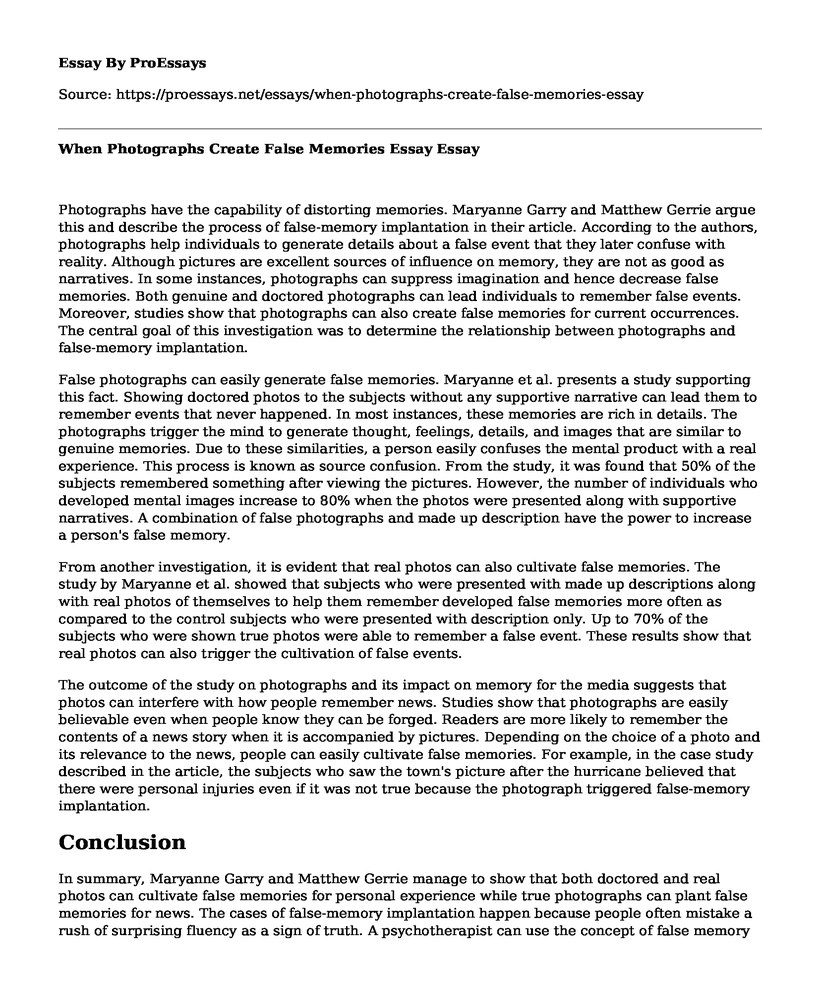Photographs have the capability of distorting memories. Maryanne Garry and Matthew Gerrie argue this and describe the process of false-memory implantation in their article. According to the authors, photographs help individuals to generate details about a false event that they later confuse with reality. Although pictures are excellent sources of influence on memory, they are not as good as narratives. In some instances, photographs can suppress imagination and hence decrease false memories. Both genuine and doctored photographs can lead individuals to remember false events. Moreover, studies show that photographs can also create false memories for current occurrences. The central goal of this investigation was to determine the relationship between photographs and false-memory implantation.
False photographs can easily generate false memories. Maryanne et al. presents a study supporting this fact. Showing doctored photos to the subjects without any supportive narrative can lead them to remember events that never happened. In most instances, these memories are rich in details. The photographs trigger the mind to generate thought, feelings, details, and images that are similar to genuine memories. Due to these similarities, a person easily confuses the mental product with a real experience. This process is known as source confusion. From the study, it was found that 50% of the subjects remembered something after viewing the pictures. However, the number of individuals who developed mental images increase to 80% when the photos were presented along with supportive narratives. A combination of false photographs and made up description have the power to increase a person's false memory.
From another investigation, it is evident that real photos can also cultivate false memories. The study by Maryanne et al. showed that subjects who were presented with made up descriptions along with real photos of themselves to help them remember developed false memories more often as compared to the control subjects who were presented with description only. Up to 70% of the subjects who were shown true photos were able to remember a false event. These results show that real photos can also trigger the cultivation of false events.
The outcome of the study on photographs and its impact on memory for the media suggests that photos can interfere with how people remember news. Studies show that photographs are easily believable even when people know they can be forged. Readers are more likely to remember the contents of a news story when it is accompanied by pictures. Depending on the choice of a photo and its relevance to the news, people can easily cultivate false memories. For example, in the case study described in the article, the subjects who saw the town's picture after the hurricane believed that there were personal injuries even if it was not true because the photograph triggered false-memory implantation.
Conclusion
In summary, Maryanne Garry and Matthew Gerrie manage to show that both doctored and real photos can cultivate false memories for personal experience while true photographs can plant false memories for news. The cases of false-memory implantation happen because people often mistake a rush of surprising fluency as a sign of truth. A psychotherapist can use the concept of false memory development to help clients reframe unpleasant memories. Furthermore, studies have shown that doctored photographs can be used to trigger a false-me0mory account among clients with maladaptive behaviors and, as a result, improve their condition.
References
Garry, M., & Gerrie, M. P. (2005). When photographs create false memories. Current Directions in Psychological Science, 14(6), 321-325.
Cite this page
When Photographs Create False Memories Essay. (2022, Jul 25). Retrieved from https://proessays.net/essays/when-photographs-create-false-memories-essay
If you are the original author of this essay and no longer wish to have it published on the ProEssays website, please click below to request its removal:
- Writing Assignment Example: Burnout Dependance on Coping Style and Stress
- Effects of Social Media on Physical and Mental Health Essay
- My Biography as a Marriage and Family Therapy Paper Example
- Capgras Syndrome Essay Example
- Occupational Health and Safety Administration Cites Missouri Plumbing Company - Essay Sample
- Essay Sample on Christian Reformers as Heroes
- Essay Example on Jane: A Life of Love and Loss







